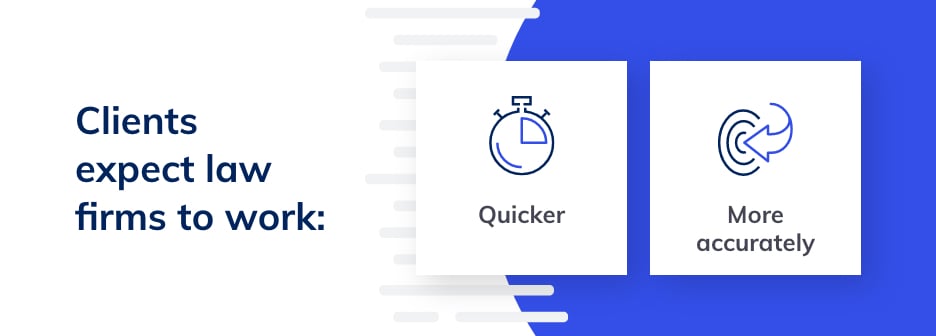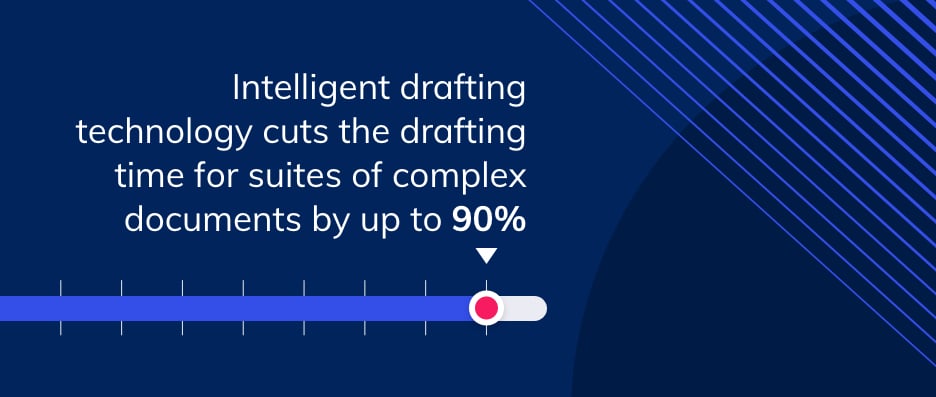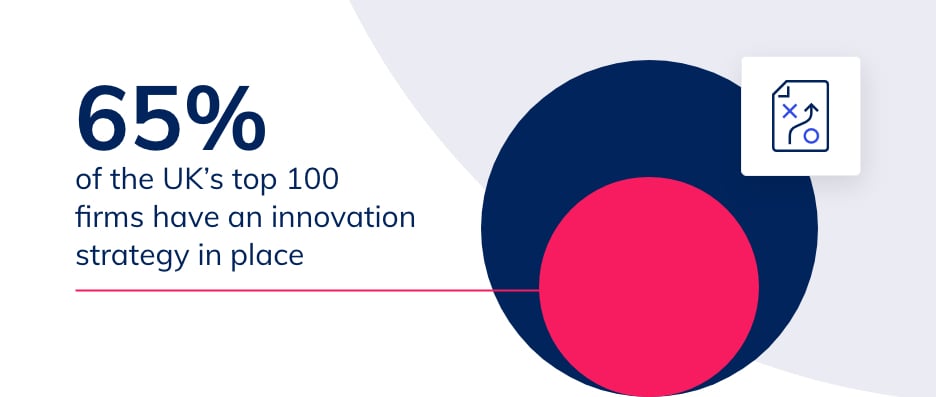Increase productivity, transform your profitability, and safeguard your firm’s future.
Law firms are facing growing competition. In order to survive, they need to distinguish themselves from the pack and ensure that their firm is focused on high-value activities.
Yet too many lawyers spend valuable time on repetitive, low-value, mundane, or administrative tasks. 45% are surprised by the volume of these tasks—with 34% wanting to see their firm invest in technologies that do part of the legal service—and 18% report that the majority of their time is taken up by these activities.
One such task is document drafting, which has many routine and mechanical aspects that can be automated. But firms that have adopted traditional document automation toolkits have been left unimpressed. So what’s the solution? The right type of technology. Specifically, intelligent drafting technology.
Throughout this piece, we’ll explore how intelligent drafting technology can help law firms beat the competition and safeguard their future.
Key challenges faced by law firms and how technology can help
Losing work to competition
The UK legal market has never been more competitive. Moreover, the sharp rise of alternative legal service providers (ALSPs) poses another cause for concern. Law firms have to rethink their approach.
Fortunately, there are real ways to differentiate your firm from the competition, technology being a key factor. Nowadays, clients increasingly expect law firms to be using cutting-edge solutions to make their work quicker and more accurate.

Firms that demonstrate a willingness to use the appropriate technology will undoubtedly impress potential clients. While many firms are still struggling to make an impact with document automation toolkits, those that use intelligent drafting technology are cutting turnaround times and improving their service—they’re spending less time on non-value-added work and more on strategic activities. In short, they’re making themselves more attractive to new clients.
Lawyers are working on non-value-added activity
Imagine the impact on your revenue if your experienced fee earners focused solely on high-value, client-facing activities—instead of spending hours each day on more mundane tasks.
Take document drafting, for example. This has long been seen as a necessary—albeit time-consuming and sometimes tedious—part of a lawyer’s job. However, intelligent drafting technology cuts the drafting time for suites of complex documents by up to 90%. For example, where it might have taken a fee earner 5 hours to produce a first draft contract, it would now be complete in 30 minutes.

Fee earners can now spend the extra time on work that brings in more revenue for the firm: providing more bespoke and strategic service to clients, which enhances client satisfaction and improves retention.
Improving the rate, yield, and utilisation of the team
Currently, law firms are not always helping fee earners optimise their time. Senior lawyers may be spending time on activities that could be delegated to junior lawyers. Tasks that could be automated, like complex drafting, are still being done manually. Tracking tasks and time spent, to identify opportunities for optimisation, is difficult and time-consuming.
To improve the rate, yield, and utilisation of their team, law firms need to embrace innovation—though this may be harder than it seems. Indeed, only 65% of the UK’s top 100 firms have an innovation strategy in place.

Start small and achieve quick wins—such as implementing intelligent drafting technology. This dramatically streamlines the document production process and paves the way for effective delegation. Let junior employees be responsible for initial drafting, with minimal chance of errors, and leave experienced experts in charge of your firm’s most profitable and most pressing strategic work. Effective automation also means that more work can be processed, delivering a higher yield.
Maintaining accuracy and consistency
Despite the use of precedents, accuracy and consistency is always a key area of focus. This ranges from keeping to house style, to ensuring there are no errors or inaccuracies which could delay proceedings. While precedents do save time in preparing draft documents, capturing knowledge, and reducing risk, automation is the logical next step in ensuring even greater efficiency.
A firm that implements intelligent drafting technology can be confident in quickly producing accurate, higher quality documents in line with the latest approved precedents—thereby de-risking the process. Freehand drafting is cut to an absolute minimum because the platform understands legal documents and can automate advanced elements including data, entities, structure, definition, logic, formatting, and cross-referencing.
Automation should be the solution—why isn’t it working?
Technology has already been introduced into the legal profession, though far from successfully. Traditional document automation toolkits drain too much time and resources with their ‘Lego bricks’ approach—they supply firms with unassembled parts rather than working automations. Firms are stuck trying to build and maintain their automations, to varying degrees of success, instead of using them to deliver immediate value.
That’s where intelligent drafting technology, delivered as a managed service, comes in. The solution is entirely built, tested, and maintained by the provider’s lawyer-led team of automation experts—leaving the firm to focus on the core work of servicing clients.
Carving out a competitive advantage
How can law firms find a way to safeguard their future success in a highly competitive arena? Technology is a fundamental part of the answer.
The right solutions—including intelligent drafting technology from Clarilis—will allow firms to beat the competition, free up their fee earners’ valuable time for higher value work, improve their firm’s yield, and improve quality and accuracy at the same time.
Key takeaways
- Law firms should be looking to harness technology to achieve competitive advantage.
- The right solutions increase a firm’s productivity and yield while simultaneously improving accuracy and quality.
- Adopt intelligent drafting technology to draft documents more quickly and delegate the process to junior employees. Free up experienced fee earners’ time.
- Unlike document automation toolkits, intelligent drafting technology from Clarilis delivers quick value, which is maintained over time, thanks to a managed service.



